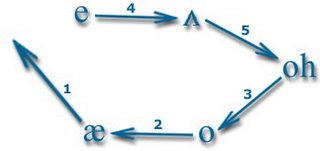Living Linguistics Tidbits
Recently, some of my ESL students (all Japanese at the moment) have been asking me about whether there are any American dialects. I know of course, both firsthand and via my Intro to Linguistics course from a few years back, that there are a great many dialects in America, but I'm not so good at impersonating them, and I don't have a full enough understanding to be able to describe the differences in a meaningful way. So it was fortuitous that I stumbled upon a CNET link to a recent All Things Considered piece from February 16 entitled "American Accent Undergoing Great Vowel Shift" (the linked page includes audio files in both Windows Media and RealAudio formats). Interviewer Robert Seigel spoke with Professor William Labov, a linguist from the University of Pennsylvania, and I found their conversation to be fascinating. Professor Labov is the author of the newly released Atlas of North American English Phonetics, Phonology and Sound Change, which I'm happy to report includes a CD-ROM with interactive maps and audio samples which supports his research. For somebody like me who has a basic understanding of linguistics but is not 100% confident in his ability to replicate IPA symbols with complete accuracy, it's a great addition to what seems like a fascinating (but staggeringly expensive for students like myself at 598 euros/106,993 yen/$620). I probably won't buy it unless I can somehow get a student discount, but luckily it's possible to sample the multimedia content by registering with the book's German publisher.
Some of the content available once one registers involves something called the "Northern Cities Shift." I thought I would post an image and a description here for easy viewing, but the following content is copyrighted material by Professor Labov, his co-authors, and perhaps the University of Pennsylvania. I will remove it immediately if any of the above wish me to do so.
So thanks to Professor Labov, I finally have come to understand part of what makes Midland and Northern Cities' accents so distinctive.
-------
EDIT: I changed the two images in the above post so that the publisher of the book would not have to field traffic from my blog. Not that anybody even reads this, but just wanted to change it out of principle.
Some of the content available once one registers involves something called the "Northern Cities Shift." I thought I would post an image and a description here for easy viewing, but the following content is copyrighted material by Professor Labov, his co-authors, and perhaps the University of Pennsylvania. I will remove it immediately if any of the above wish me to do so.
"The Northern Cities Shift is a chain shift affecting the short vowels of the English spoken in U.S. regions bordering the Great Lakes. It is triggered by the general raising of all /æ/ vowels in man, that, back, etc. followed by the fronting of /o/ in got, cot, socks and the lowering of /oh/ in caught, lawn, law, etc. Short /e/ then shifts back to the center of the mouth, and // moves back to the position formerly occupied by /oh/."
...
"The region of Western Pennsylvania is a part of the original Midland area that was distinguished from the rest at an early stage by a complete form of the low back merger of /o/ and /oh/.At its center is the city of Pittsburgh, which is marked by the glide deletion of /aw/. It shares with other Midland areas the fronting of /ow/ as well as /uw/."
So thanks to Professor Labov, I finally have come to understand part of what makes Midland and Northern Cities' accents so distinctive.
-------
EDIT: I changed the two images in the above post so that the publisher of the book would not have to field traffic from my blog. Not that anybody even reads this, but just wanted to change it out of principle.


